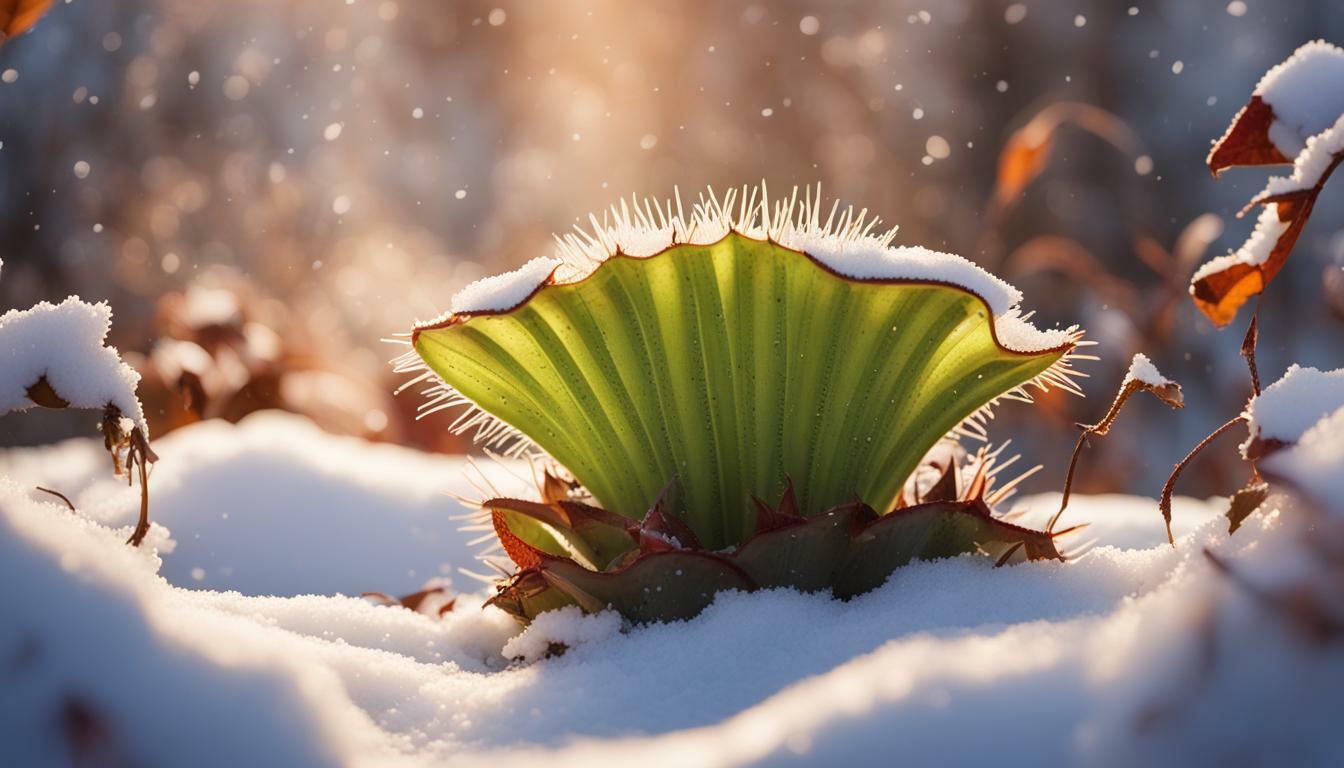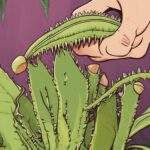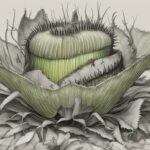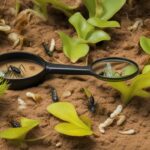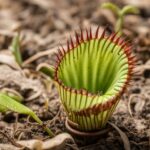Venus flytraps are fascinating carnivorous plants that capture insects for their survival. If you are a plant enthusiast and own a Venus flytrap, you may be wondering if it needs a dormant period. The answer is yes! Dormancy is an essential phase in the plant’s life cycle, and understanding its significance can help you provide the necessary care for your Venus flytrap to thrive.
Key Takeaways:
- Venus flytraps require a dormant period to thrive.
- Understanding the life cycle of Venus flytraps can help with care.
- Proper preparation and care during dormancy are crucial for the plant’s health.
Understanding Venus Flytraps and Their Life Cycle
If you’re interested in keeping Venus flytraps as houseplants, it’s important to understand their unique characteristics and life cycle. These carnivorous plants require specific care to thrive, but with a little knowledge, you can enjoy the beauty of these fascinating plants for years to come.
Venus flytraps are native to the bogs and swamps of the southeastern United States and are known for their unique ability to capture and digest insects for nutrition. This carnivorous nature is part of what makes these plants so intriguing.
When it comes to caring for Venus flytraps, it’s important to remember that they have a seasonal life cycle. During the active growing season (spring and summer), they require plenty of sunlight, warm temperatures, and consistent watering. However, during the dormant period (fall and winter), they need specific environmental conditions to prepare for the next growing season.
Care Tips for Venus Flytraps
To keep your Venus flytrap healthy throughout its life cycle, consider these care tips:
- Provide bright, direct sunlight for several hours each day.
- Use a well-draining soil mixture, such as a 50/50 blend of sphagnum peat moss and perlite.
- Water with distilled or rainwater only, as tap water can contain minerals that are harmful to the plant.
- Avoid fertilizing the plant, as it gets its nutrients from insects.
- Be careful not to overwater, as Venus flytraps prefer moist, but not soggy soil.
By following these care tips and understanding the life cycle of Venus flytraps, you can enjoy the beauty and intrigue of these unique plants in your own home.
The Significance of Dormancy in Venus Flytraps
If you’re a Venus flytrap owner, you’ve probably heard about the importance of dormancy. This is a crucial period in the plant’s life cycle, during which it undergoes rest and replenishment needed for healthy growth and development. Understanding and properly caring for Venus flytraps during their dormant period is essential to their overall health and longevity.
Venus flytrap dormancy typically occurs in the winter months, triggered by shorter days and cooler temperatures. During this phase, the plant’s leaves will stop growing, and the traps may turn black or brown, indicating a period of rest. However, it’s important to note that not all Venus flytraps will experience dormancy, as this can depend on a variety of factors such as growing location, climate, and age.
If your Venus flytrap does enter dormancy, it’s crucial to adjust your care routine accordingly. During this period, the plant will require less water, as it’s not actively growing or consuming insects. Over-watering during dormancy can lead to root rot and other issues. It’s also important to reduce the amount of light exposure, as the plant is not photosynthesizing and doesn’t require as much energy as in active growth phases.
Temperature is another critical factor to consider during Venus flytrap dormancy. Most Venus flytraps will require temperatures between 35-50°F (2-10°C) for successful dormancy. If you live in a warmer climate, you may need to provide a cooler environment by moving the plant to an unheated garage or basement. You can also use ice packs or a refrigeration unit to achieve the required temperature range.
In conclusion, proper care and attention during Venus flytrap dormancy are crucial for maintaining the plant’s overall health and longevity. By adjusting your watering, light exposure, and temperature conditions, you can ensure that your Venus flytrap emerges from dormancy strong and healthy, ready for the active growth phase.
Venus Flytrap Dormancy: Understanding the Process
During the winter months, Venus flytraps enter a period of dormancy. This is a natural process that helps the plant conserve energy and prepare for new growth in the spring. Understanding the dormancy process is important for any Venus flytrap owner, as it can impact the plant’s overall health and longevity.
| Timing | Temperature | Light |
|---|---|---|
| Venus flytraps typically enter dormancy in late fall or early winter. | The plant requires a consistent temperature of around 45-50°F (7-10°C) during dormancy. | The plant should be kept in a location with limited light exposure, such as a closed container or dark closet. |
During dormancy, it’s important to avoid disturbing the plant as much as possible. The Venus flytrap will typically appear dormant, with little to no new growth or movement.
As the winter months come to an end and the weather begins to warm up, the Venus flytrap will begin to emerge from dormancy. However, it’s important to provide the plant with the proper care to support this new growth phase.
Proper care during dormancy, including appropriate temperature, watering, and light exposure, will help ensure a healthy and successful emergence from dormancy in the spring. By following these guidelines for Venus flytrap winter care and hibernation, you can help your plant thrive for years to come.
Preparing Venus Flytraps for Dormancy
If you want your Venus flytrap to thrive, it’s essential to prepare it for dormancy. During this period, the plant slows down its growth and focuses on conserving energy. Here are some tips to help you prepare your Venus flytrap for dormancy:
| Tip | Description |
|---|---|
| Reduce watering | As fall approaches, gradually reduce your Venus flytrap’s watering to once a week. This will help the plant adjust to reduced light conditions and lower temperatures. |
| Adjust light exposure | As daylight hours shorten, move your Venus flytrap to a brighter location, such as a south-facing windowsill. This will help the plant continue to photosynthesize and build up energy for dormancy. |
| Provide proper temperature | Venus flytraps require temperatures between 35°F and 50°F (2°C to 10°C) during dormancy. You can achieve this by moving your plant to a cool location, such as a garage or unheated basement. |
| Avoid fertilizing | Do not fertilize your Venus flytrap during dormancy. The plant won’t be actively growing, and fertilizer can actually harm it. |
| Prune any dead leaves | Before dormancy, remove any dead or dying leaves from your Venus flytrap. This will help the plant conserve energy and prevent the spread of disease or pests. |
By following these tips, you’ll be giving your Venus flytrap the best possible chance for healthy dormancy.
Caring for Venus Flytraps During Dormancy
During the dormant period of Venus flytraps, it is important to provide them with proper care to ensure their health and successful emergence from dormancy. Follow these care tips to ensure your Venus flytrap stays healthy throughout its dormant period:
Watering
During dormancy, you should reduce watering intervals. Venus flytraps require consistently moist soil, but during the dormant period, water the plant only when the soil is almost dry. Overwatering can cause root rot, which can be fatal for the plant.
Light Exposure
Venus flytraps require bright, direct sunlight to thrive, but during the dormant period, reduce their exposure to light. Place the plant in a cool, dark location for approximately 12-14 hours each day. This reduced light exposure helps the plant conserve energy during dormancy.
Temperature
Venus flytraps require a specific temperature range to enter and emerge successfully from dormancy. The optimal temperature range is between 35-45°F (1-7°C). If the temperature falls below this range, cover the plant with a layer of mulch or move it indoors.
Handling the Plant
Do not feed your Venus flytrap during the dormant period, as the plant cannot digest food without proper light and temperature conditions. Additionally, avoid fertilizing the plant during dormancy, as it can cause the plant to develop new growth prematurely, which can be harmful to the plant.
By following these care tips, you can ensure the health and longevity of your Venus flytrap during its dormant period. Remember to maintain the proper care and preparation to ensure the plant’s overall health and successful emergence from dormancy.
Signs of Dormancy Ending and Preparing for Growth
As winter comes to a close, you may notice some changes in your Venus flytrap as it prepares to emerge from dormancy. Here are some key signs to look out for:
- The plant will begin to produce new leaves, a sign that it is ready to resume active growth.
- The leaves may also change color, becoming greener and more vibrant.
- The traps will start to open and close again, indicating that the plant is once again catching prey.
It’s important to remember that your Venus flytrap may take some time to fully emerge from dormancy and return to its active state. Be patient and monitor the plant closely during this transition period.
As your Venus flytrap prepares for growth, there are some steps you can take to help support a successful transition:
- Gradually increase watering, taking care not to overwater the plant.
- Gradually increase light exposure, but avoid exposing the plant to direct sunlight too soon.
- Consider fertilizing the soil with a diluted all-purpose liquid fertilizer to provide nutrients for new growth.
Keep in mind that your Venus flytrap may be more vulnerable during this transition period, so be sure to handle the plant with care and avoid any drastic changes to its environment. With proper care, your Venus flytrap will soon be back to its thriving, carnivorous self.
The Importance of a Dormant Period for Venus Flytraps
If you’re a Venus flytrap owner, you may be wondering whether your plant needs a dormant period. The answer is yes! A dormant period is crucial for the overall health and longevity of your Venus flytrap. During this phase, the plant slows down its growth and conserves energy, allowing it to survive harsh weather conditions and prepare for new growth in the spring.
Understanding the life cycle of Venus flytraps and the significance of dormancy is key to providing the appropriate care for your plant. During the active growing season, Venus flytraps require consistent moisture and light exposure. However, during dormancy, their needs change significantly.
The Significance of Dormancy in Venus Flytraps
Dormancy is a natural phase in the life cycle of Venus flytraps. It typically occurs during the winter months, triggered by changes in temperature and light exposure. During this phase, your Venus flytrap will stop growing, and its leaves may turn brown or black.
To ensure a healthy and vigorous plant, it’s important to understand the specific care requirements during dormancy. Your Venus flytrap will require less water and a significant reduction in sunlight exposure. In addition, you’ll need to maintain the appropriate temperature range to encourage successful dormancy.
Preparing Venus Flytraps for Dormancy
Proper preparation for dormancy is critical to the health of your Venus flytrap. As temperatures begin to drop, gradually reduce watering to avoid oversaturating the soil. This will mimic the natural reduction in moisture that occurs in the plant’s native habitat.
It’s also important to adjust the light exposure for your Venus flytrap during dormancy. If your plant is indoors, consider moving it to a cooler location with reduced natural light. Alternatively, you can cover it with a black plastic bag to minimize light exposure.
Caring for Venus Flytraps During Dormancy
During dormancy, it’s important to avoid fertilizing your Venus flytrap and minimize any disturbance to the soil. Instead, focus on maintaining the appropriate temperature range and limiting water availability. This will support successful dormancy and prepare your plant for new growth in the spring.
Signs of Dormancy Ending and Preparing for Growth
As the winter months come to an end, you’ll begin to notice signs that your Venus flytrap is emerging from dormancy. The leaves will start to turn green again, and you may notice new growth appearing.
To encourage successful growth, gradually increase watering and adjust the light exposure for your Venus flytrap. As the plant resumes active growth, it will require more consistent watering and exposure to natural sunlight.
Conclusion
In conclusion, a dormant period is crucial for the health and longevity of your Venus flytrap. By understanding the specific care requirements during this phase, you can ensure a vigorous and thriving plant. Proper preparation, care, and gradual transition back to active growth will support the overall health of your Venus flytrap and provide years of enjoyment.
Is Repotting a Venus Flytrap Necessary During its Dormant Period?
During the dormant period of a Venus Flytrap, repotting is not necessary. However, if you do choose to repot your Venus Flytrap, it is important to follow a repotting a venus flytrap guide to ensure the process is done correctly. Remember to handle the delicate roots carefully and provide adequate care afterward to allow for a successful transition.
FAQ
Q: Do Venus flytraps need a dormant period?
A: Yes, Venus flytraps require a dormant period to thrive. It is a natural part of their life cycle and is essential for their overall health and longevity.
Q: What is the significance of dormancy in Venus flytraps?
A: Dormancy allows Venus flytraps to conserve energy and prepare for growth in the upcoming season. It promotes root development and overall plant health.
Q: How long does the dormant period typically last?
A: The dormant period for Venus flytraps usually lasts from late fall to early spring, typically lasting around three to four months.
Q: What are the environmental conditions needed for successful dormancy?
A: During dormancy, Venus flytraps require cooler temperatures, usually around 50-55 degrees Fahrenheit (10-13 degrees Celsius), and reduced light exposure.
Q: How should I prepare my Venus flytraps for dormancy?
A: To prepare your Venus flytraps for dormancy, gradually reduce watering and adjust their light exposure to simulate the conditions of their natural habitat.
Q: What care is needed during the dormant period?
A: During dormancy, Venus flytraps should be kept in a cool location with minimal watering. It is important to avoid fertilizing or disturbing the plant during this time.
Q: How do I know when dormancy is ending and the plant is ready to grow again?
A: Signs that dormancy is ending include the emergence of new growth, such as small leaves or traps. You can gradually increase watering and adjust light conditions to support new growth.

